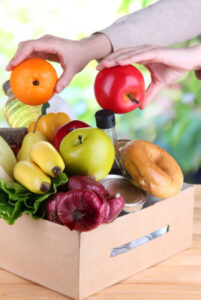You Can Help Feed the Hungry With Your Humble Garden

Congratulations, you’re a successful gardener! You’ve grown enough food to post humblebrag photos on Instragram and Twitter. Your office lunches are the envy of everyone with noodles in a cup, and even your crunchy, hemp-wearing aunt is impressed. But there’s more–much more. Did you know you can help feed the hungry with your backyard bounty?
Yep, all those tomatoes that you don’t know what to do with, those green beans en masse. And even though you stopped watering, the summer squash just keep on coming. Don’t let any of it go to waste–share it with people who truly need it. In fact, many gardeners grow produce specifically for the purpose of donating it to food pantries. Others donate produce when they have more than they can use and don’t want to waste it.
Hunger is a chronic problem.
According to World Hunger, one in seven American households experience food insecurity.
Adults often shield children from hunger by forgoing food themselves. Never the less, according to FeedingAmerica.org: “Twenty percent or more of the child population in 38 states and the District of Columbia live in food-insecure households…D.C. and Mississippi have the highest rates of children in households without consistent access to food.”
The problem of chronic food insecurity is not going away.
Why produce is so important to food insecure neighbors
Food pantries receive donations of canned goods, boxes of neon-colored cereal, day-glow macaroni and cheese, and odd ball items that no one wants (remember the green ketchup trend?).
While food pantries are grateful to receive most of this food their clients crave the same food that you want–healthy, beautiful produce. These clients want to feed their families the same healthy foods that you feed your family.
More need in the summer.
In the dead of winter food pantries benefit from holiday spirit-fueled generosity. This is great, but it means that at the height of the growing season–summer–is when food pantry shelves are most bare. This trend is counterintuitive to what most people expect.
“People need more help in the summer,” says Megan Gendron, director of development and public relations at York County shelter and food pantry in Alfred, ME. “The shelter and pantry are at peak during the summer months,” she adds.
Gendron reports that seeing the fresh garden produce arrive at the York County Shelter is a “morale boost” for staff because they know how pleased the clients will be to receive it. “It’s really keeping us running day to day,” she says.
Here’s how you can help:
Pick up the phone and call your local food pantry. Check out Feeding America to find a pantry near you.
Ask them if they are accepting donations of produce. Most are, but some do not have the refrigeration necessary so they prefer items that don’t need to be kept chilled.
If the food pantry that you contact isn’t accepting donations of fresh produce then they may accept home-canned items such as tomatoes or dilly beans.
Also, check out these national organizations that are happy to receive donations of garden produce:
Plant a Row
The Garden Writers Association created the Plant a Row program to encourage the donation of produce.
According to their website: “The purpose of Plant A Row is to create and sustain a grassroots program…to encourage readers/listeners to donate surplus garden produce to local food banks, soup kitchens, and service organizations to help feed America’s hungry.”
Ample Harvest
The mission of Ample Harvest is, “To eliminate the waste of fresh food, hunger and malnutrition in your own community. AmpleHarvest.org connects 42 million Americans with excess food in their garden and local food pantries. Garden by garden, home & community gardeners and other growers are fighting hunger and malnutrition in America. Our core mission: No Food Left Behind.”
Feeding America
This group aims to “feed America’s hungry through a nationwide network of member food banks and engage our country in the fight to end hunger.”
Rally the troops!
Maybe your kiddos don’t enjoy eating kale, but they will probably like growing it! Having kids grow food to donate is an empowering way to teach them about their neighbors in need. While statistics on childhood hunger are abstract for four year-olds, they can understand the importance of sharing.
Contact your child’s school to see if they have a community garden. If they do, then ask if some of the produce can be donated. If not, maybe you can get one started.
Feel good about yourself–you’ve done a great thing. Not only have you shared food with neighbors who truly need it, you’ve shared healthy, whole foods with them.
Related on Organic Authority
USDA School Lunch Test Program Provides 3 Square Meals a Day For At-Risk Youth
Image of food going into donation box via Shutterstock

